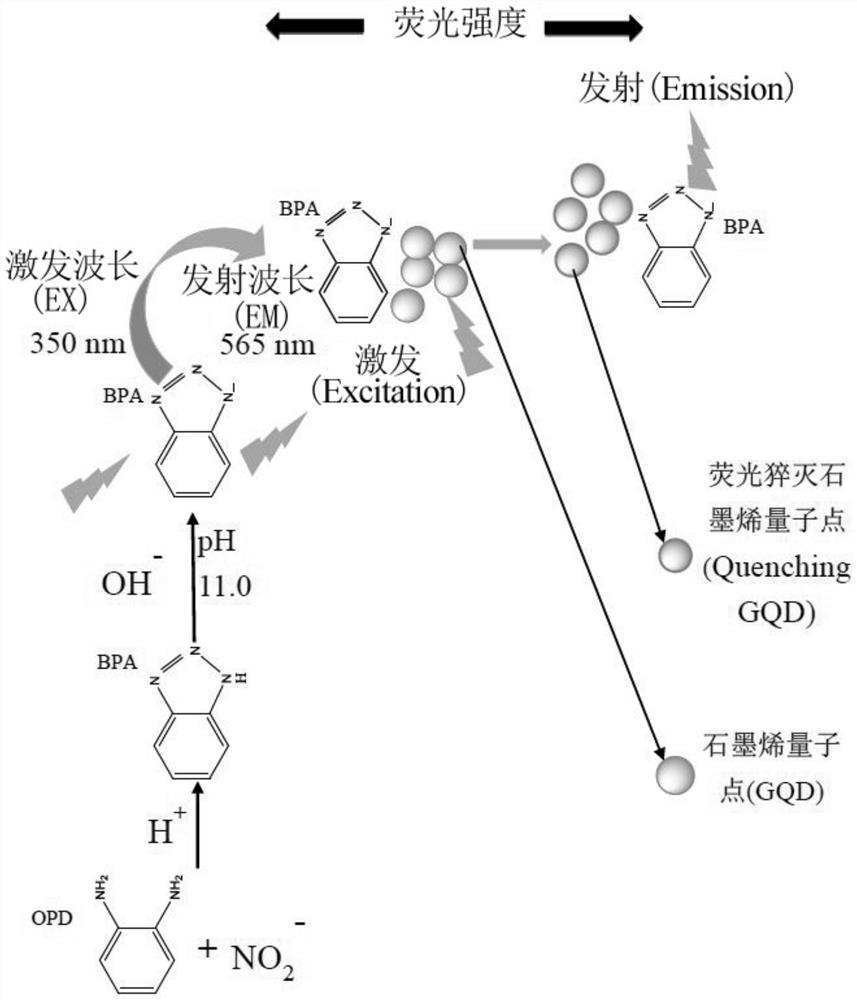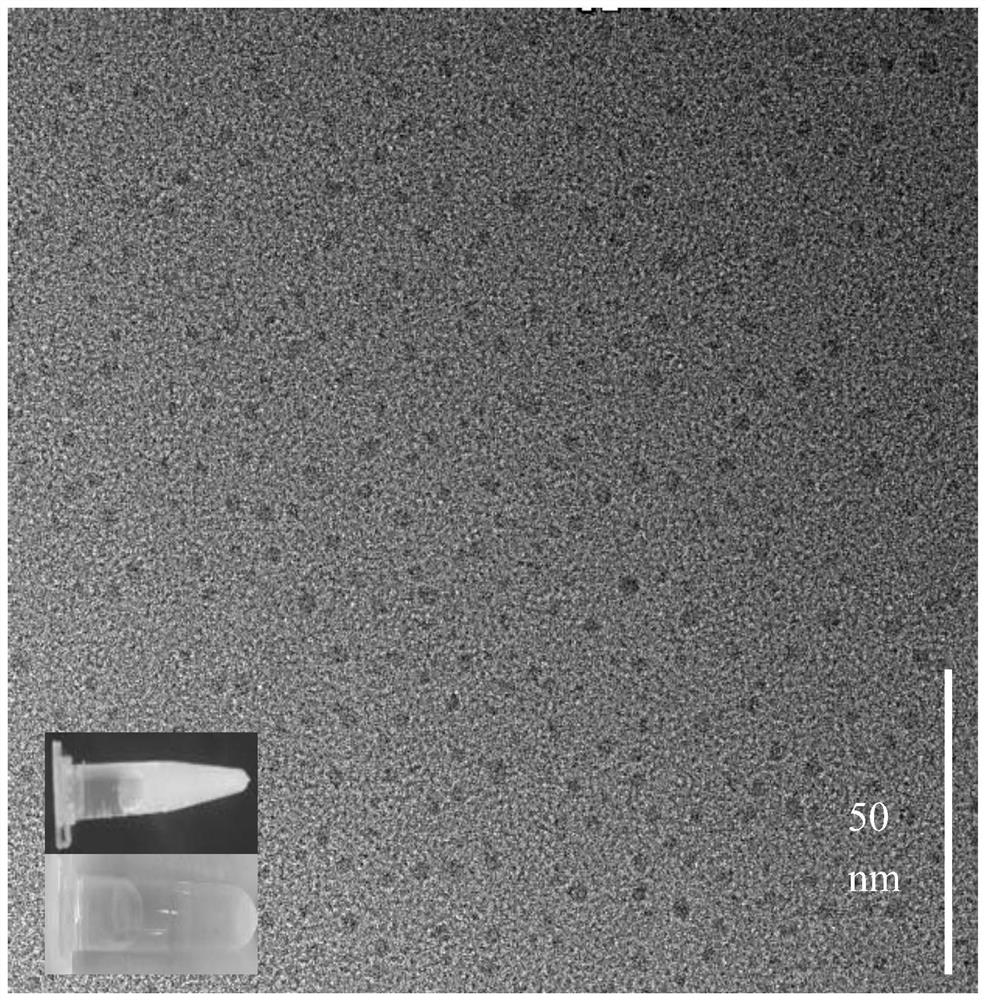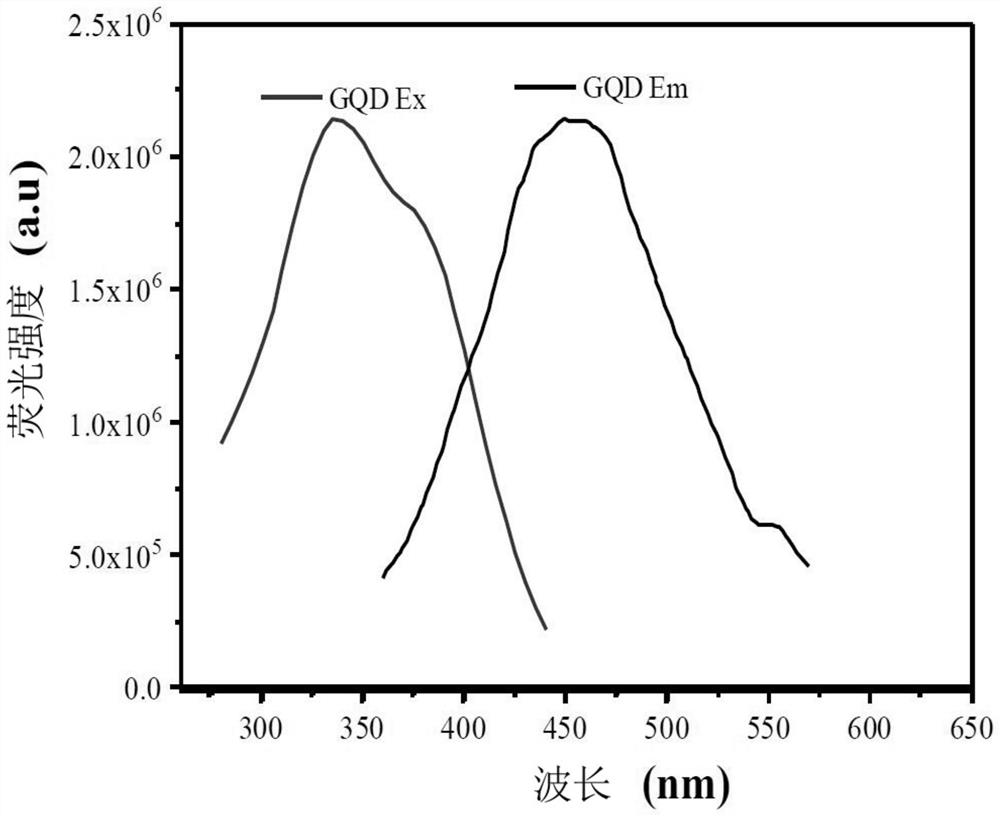A Ratiometric Fluorescence Analysis Method for Detecting Nitrite
An analytical method and a nitrite technology are applied in the field of fluorescence analysis to achieve the effects of simple synthesis, broad application prospects, and high precision and sensitivity
- Summary
- Abstract
- Description
- Claims
- Application Information
AI Technical Summary
Problems solved by technology
Method used
Image
Examples
Embodiment 1
[0044] The present embodiment provides a ratiometric fluorescence analysis method for detecting nitrite, which specifically includes the following steps:
[0045] Step S11. Synthesis of graphene quantum dots: Weigh 2.0g of anhydrous citric acid in a 250mL beaker, place it in an electrochemical oven and heat to 200°C, keep the temperature for 30min, and observe that the citric acid turns into a pale yellow liquid, take it out, and put it into a light yellow liquid. Add 100 mL of sodium hydroxide with a concentration of 10 mg / mL dropwise, and stir vigorously while adding dropwise; finally neutralize with sodium hydroxide to pH=7.0 to obtain an aqueous solution of graphene quantum dots; store in a refrigerator at 4°C in the dark, and dilute 8 times;
[0046] from Figure 2A It can be seen that the particle size distribution of the prepared graphene quantum dots is relatively uniform, and there is strong blue fluorescence under the 365nm UV lamp. The optimal excitation wavelengt...
Embodiment 2
[0055] The present embodiment provides a ratiometric fluorescence analysis method for detecting nitrite, which specifically includes the following steps:
[0056] Step S21. Synthesis of graphene quantum dots: Weigh 2.0g of anhydrous citric acid in a 250mL beaker, place it in an electrochemical oven and heat it to 200°C, keep the temperature for 1h, and observe that the citric acid turns into a light yellow liquid, take it out, and put it into a light yellow liquid. Add 100 mL of sodium hydroxide with a concentration of 8 mg / mL dropwise, stir vigorously while adding dropwise; finally neutralize it with sodium hydroxide to pH=6.5 to obtain an aqueous solution of graphene quantum dots; store it in a refrigerator at 4°C in the dark, and dilute it by 10 when in use. times;
[0057] Step S22. Establishment of a standard curve: use 0.05M hydrochloric acid to prepare standard solutions of sodium nitrite with different concentrations (1.29×10 -5 ~6900mg / kg) and o-phenylenediamine solu...
Embodiment 3
[0060] The present embodiment provides a ratiometric fluorescence analysis method for detecting nitrite, which specifically includes the following steps:
[0061] Step S31. Synthesis of graphene quantum dots: Weigh 2.0g of anhydrous citric acid in a 250mL beaker, place it in an electrochemical oven and heat to 200°C, keep the temperature for 30min, and observe that the citric acid turns into a pale yellow liquid, take it out, and put it into a light yellow liquid. Add 100 mL of sodium hydroxide with a concentration of 5 mg / mL dropwise, and stir vigorously while adding; finally neutralize it with sodium hydroxide to pH=7.5 to obtain an aqueous solution of graphene quantum dots; store it in a refrigerator at 4°C in the dark, and dilute 6 times;
[0062] Step S32. Establishment of a standard curve: use 0.5M hydrochloric acid to prepare standard solutions of sodium nitrite with different concentrations (1.29×10 -5 ~6900mg / kg) and o-phenylenediamine solution with a concentration o...
PUM
| Property | Measurement | Unit |
|---|---|---|
| linear range | aaaaa | aaaaa |
| Sensitivity | aaaaa | aaaaa |
Abstract
Description
Claims
Application Information
 Login to View More
Login to View More - R&D
- Intellectual Property
- Life Sciences
- Materials
- Tech Scout
- Unparalleled Data Quality
- Higher Quality Content
- 60% Fewer Hallucinations
Browse by: Latest US Patents, China's latest patents, Technical Efficacy Thesaurus, Application Domain, Technology Topic, Popular Technical Reports.
© 2025 PatSnap. All rights reserved.Legal|Privacy policy|Modern Slavery Act Transparency Statement|Sitemap|About US| Contact US: help@patsnap.com



